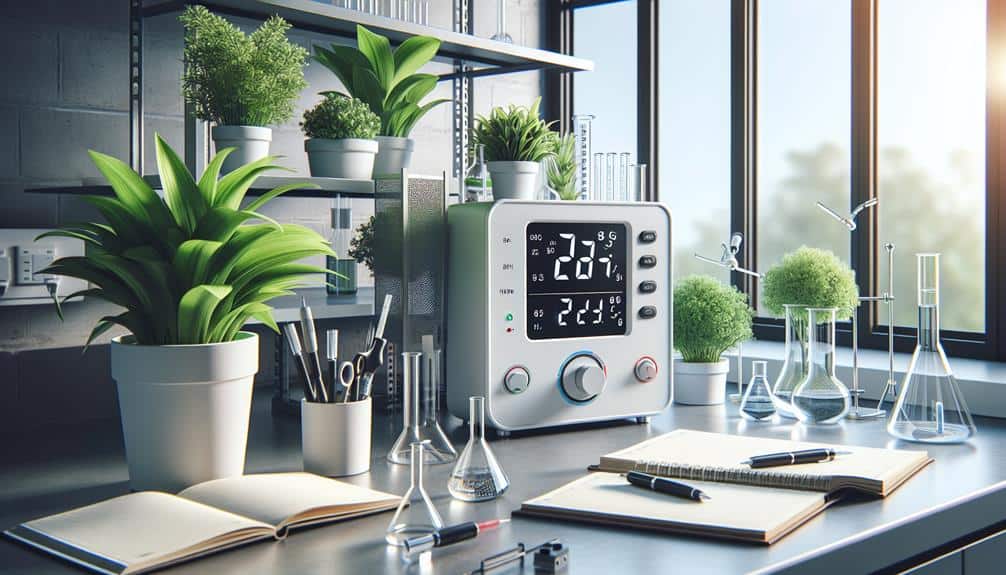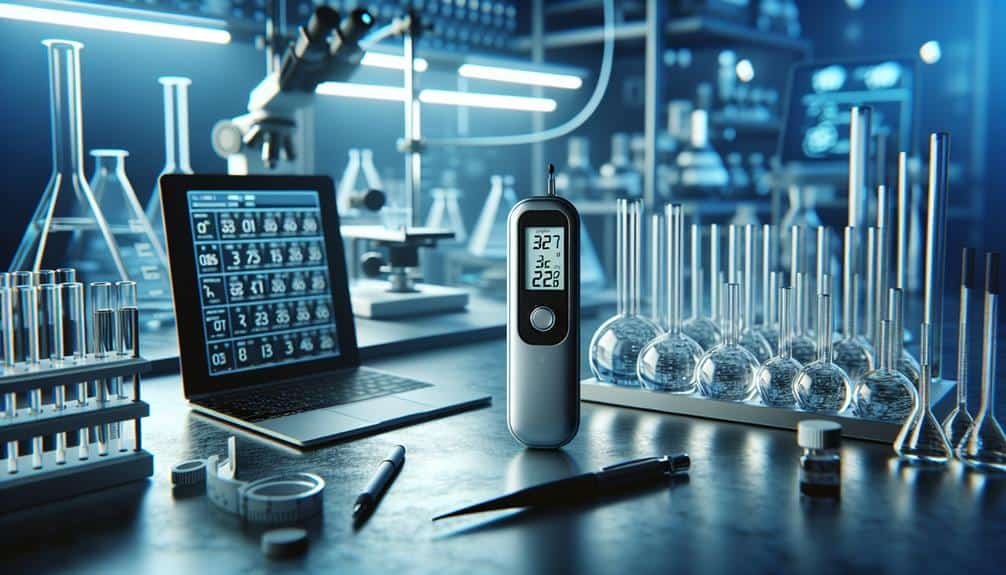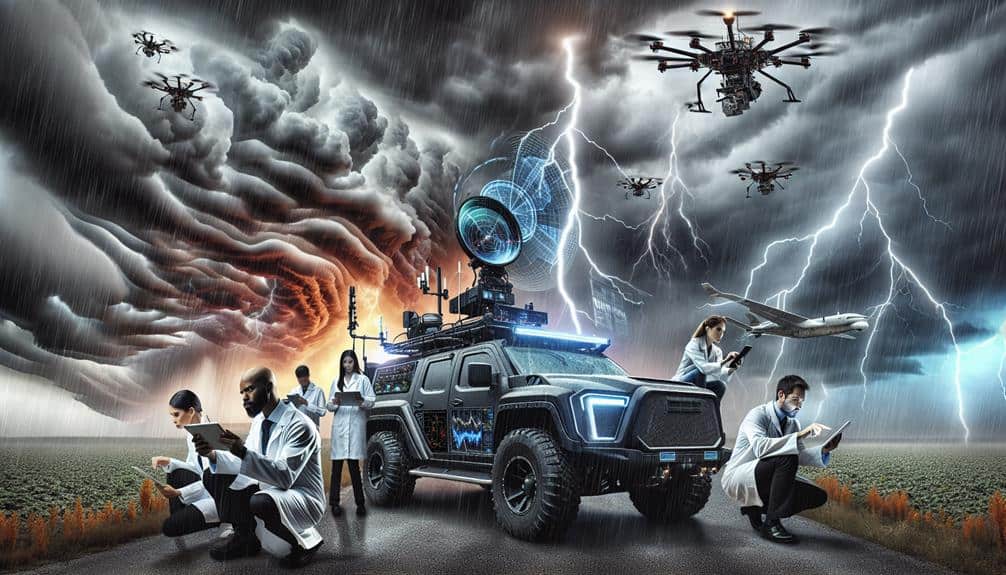We've identified the top ten tools for accurate atmospheric condition monitoring, leveraging cutting-edge technology and rigorous scientific methodology. Doppler radars and weather satellites offer extensive real-time data, enhancing prediction accuracy. Anemometers and barometers provide high-precision wind speed and atmospheric pressure measurements. Hygrometers and thermometers deliver essential humidity and temperature data. Rain gauges and lightning detectors guarantee accurate precipitation and lightning tracking. Finally, mobile weather apps integrate these tools with advanced algorithms for accessible, user-friendly forecasts. Continue to uncover how these instruments can elevate our understanding and prediction of atmospheric phenomena.
Key Points
- Doppler Radars: Provide real-time wind data and extensive coverage for severe weather prediction.
- Weather Satellites: Offer high-resolution imagery and data for accurate weather models.
- Anemometers: Measure wind speed and direction with high precision, improving weather predictions.
- Barometers: Essential for measuring atmospheric pressure, with various types like mercury, aneroid, and digital.
Doppler Radars
Doppler radars, essential for atmospheric condition monitoring, provide accurate, real-time data on wind speed and direction by measuring frequency shifts in electromagnetic waves. Using advanced Doppler radar technology, we can map extensive coverage areas, enhancing our ability to predict and respond to severe weather events. These radars emit pulses that bounce off precipitation particles, allowing us to calculate their velocity and direction by analyzing the Doppler shift—the change in frequency caused by motion.
By continuously collecting Doppler radar data, we can effectively track storms, identifying their development, intensity, and trajectory. This capability is critical for issuing timely warnings and safeguarding communities from potential hazards. Our reliance on this technology empowers us to maintain situational awareness and take proactive measures, ensuring a higher degree of safety and preparedness.
Moreover, the integration of Doppler radar data into sophisticated weather models enhances our predictive accuracy, providing a clearer picture of impending atmospheric conditions. As a result, we gain the freedom to make informed decisions, whether it's about evacuation plans or simply planning our daily activities. With extensive coverage areas and precise storm tracking, Doppler radar technology stands as an indispensable tool in modern meteorology.
Weather Satellites
Weather satellites offer us with detailed, high-resolution imagery and data important for monitoring global atmospheric conditions. By capturing images from space, these satellites allow us to conduct satellite imagery analysis, which enhances our understanding of weather patterns and environmental changes. Equipped with advanced sensors, they measure parameters like temperature, humidity, and cloud cover, providing vital information into weather prediction models.
Satellite coverage is extensive, often spanning entire hemispheres. This broad reach allows us to monitor remote and inaccessible regions, offering a complete view of atmospheric dynamics. However, data transmission limitations remain a challenge. The vast amount of data collected requires robust communication networks to guarantee timely and accurate transmission to ground stations. Delays or interruptions in data flow can impact the effectiveness of real-time weather forecasting.
Furthermore, the integration of satellite data into weather prediction models notably enhances their accuracy. By continuously updating these models with fresh data, we can generate more reliable forecasts, aiding in disaster preparedness and resource management.
As technology advances, new generations of weather satellites promise even better resolution and faster data processing, pushing the boundaries of atmospheric monitoring and giving us greater flexibility to anticipate and adapt to changing weather conditions.
Anemometers
Anemometers, vital tools in meteorology, measure wind speed and direction with high precision, providing essential data for weather analysis and forecasting. These instruments come in various types, including cup, vane, and ultrasonic anemometers, each with specific applications and advantages.
By capturing accurate wind data, we can improve our weather prediction models, aiding in everything from storm tracking to renewable energy optimization.
To guarantee our anemometers deliver reliable data, regular anemometer maintenance is necessary. This includes cleaning debris from sensors, inspecting moving parts for wear, and verifying electrical connections. Proper maintenance not only extends the lifespan of the equipment but also preserves its accuracy.
Wind speed calibration is another fundamental aspect of anemometer functionality. Over time, sensor accuracy can drift, necessitating periodic recalibration against a known standard. This process involves comparing the anemometer's readings with those of a calibrated reference device, ensuring consistency and precision in data collection.
Barometers
Let's explore barometers, focusing on their types and usage tips.
Barometers are essential for measuring atmospheric pressure. They come in various forms such as mercury, aneroid, and digital models.
We'll discuss how to select the appropriate type and optimize its usage for accurate meteorological data.
Types of Barometers
Barometers, necessary for atmospheric condition monitoring, come in various types such as mercury, aneroid, and digital, each with unique mechanisms and applications.
Mercury barometers, the earliest type, were invented by Evangelista Torricelli in 1643 and have since seen advancements in accuracy and design. These barometers use a column of mercury in a glass tube; changes in atmospheric pressure cause the mercury level to rise or fall. However, due to mercury's toxicity, we must handle and maintain them with extreme caution.
Aneroid barometers, developed in the mid-19th century, use a sealed, flexible metal chamber that expands and contracts with pressure changes. They're more portable and safer than mercury barometers, making them ideal for fieldwork.
Digital barometers are the latest advancement, using electronic sensors to measure pressure changes. They offer high precision, easier data logging, and integration with other meteorological instruments.
Regular maintenance and calibration are essential for all barometers to guarantee accurate readings. Calibration involves comparing the barometer's readings with a known standard, adjusting it as necessary. Proper maintenance extends the device's lifespan and maintains the integrity of atmospheric data we rely on for weather prediction and research.
Barometer Usage Tips
To ensure accurate atmospheric information, we must follow specific handling and operational guidelines when using barometers. Barometer calibration is vital; an uncalibrated instrument can lead to inaccurate data, distorting our understanding of atmospheric conditions. We should calibrate our barometers regularly against a known standard, ensuring accuracy.
Maintenance is equally important. Dust and debris can interfere with the barometer's sensors, so we need to keep the device clean and inspect it periodically for any signs of wear or damage. Proper storage, in a stable environment free from extreme temperature and humidity fluctuations, also extends the lifespan of our barometers.
Interpreting barometer data involves understanding how atmospheric pressure changes indicate weather trends. Rising pressure often signifies fair weather, while falling pressure suggests stormy conditions. By continuously monitoring these trends, we can predict short-term weather changes with greater precision.
Moreover, we should record data consistently, using digital tools if possible, to create thorough datasets. Analyzing these datasets over time helps us discern long-term atmospheric patterns, contributing to more dependable weather forecasting. By adhering to these guidelines, we maximize the usefulness of our barometers, ensuring they remain essential tools in atmospheric condition monitoring.
Hygrometers

Let's explore the various types of hygrometers and their accuracy levels.
We'll examine mechanical, electrical, and digital hygrometers, each with distinct measurement principles.
Types of Hygrometers
Hygrometers, essential instruments for measuring humidity, come in various types including mechanical, electrical, and psychrometric models, each with distinct mechanisms and applications.
Mechanical hygrometers utilize materials like hair or metal-paper coils that change in length or tension with humidity variations. These require regular hygrometer calibration and upkeep to guarantee accuracy.
Electrical hygrometers often use capacitive or resistive sensors, converting humidity levels into electrical signals. These models benefit from advancements in hygrometer technology, offering higher precision and real-time data logging capabilities.
Psychrometric hygrometers, or psychrometers, employ the principles of wet-bulb and dry-bulb thermometers. By measuring the temperature difference, we can determine the relative humidity. These are especially useful in environments where rapid changes in humidity need to be tracked.
Each type of hygrometer has specific applications: mechanical models are often used in household settings, electrical types are prevalent in industrial and laboratory environments, and psychrometric models find their place in meteorological stations.
As technology advances, our ability to monitor atmospheric conditions with greater accuracy and less frequent upkeep improves, providing us with the freedom to focus on interpreting data rather than worrying about equipment reliability.
Hygrometer Accuracy Levels
The precision levels of hygrometers, a crucial factor in atmospheric monitoring, hinge on the type of hygrometer and the calibration protocols employed. Digital hygrometers typically offer precision with an error margin as low as ±1%, thanks to advanced sensors and microprocessors. In contrast, analog hygrometers, while more aesthetic, generally fall within an accuracy range of ±5%.
Regular hygrometer calibration is essential to maintain reliability, ensuring that our humidity measurements remain consistent and dependable.
When comparing digital vs. analog hygrometers, digital models often require less frequent recalibration due to their robust sensor technology. However, both types benefit from periodic hygrometer maintenance to safeguard their longevity and performance. For instance, digital hygrometers need battery checks and sensor inspections, while analog models might require mechanical adjustments and protection from dust and moisture.
Implementing a rigorous calibration schedule, ideally biannually, can greatly enhance precision levels. This involves using a saturated salt solution or a calibration kit to compare the hygrometer's readings against a known standard. By prioritizing these practices, we can guarantee that our atmospheric condition monitoring remains accurate, offering us the freedom to rely on our instruments without second-guessing their validity.
Weather Balloons
Weather balloons play a vital role in collecting high-altitude atmospheric data, providing insights into temperature, humidity, and wind patterns. By deploying these balloons, we can reach altitudes up to 30 kilometers, far beyond the capabilities of ground-based instruments.
The balloon deployment process involves filling a large latex or neoprene balloon with helium or hydrogen, attaching a radiosonde, and releasing it into the atmosphere.
Once deployed, the radiosonde begins data collection. It transmits real-time measurements of temperature, humidity, and pressure back to ground stations. This data is essential for creating accurate weather models and forecasts.
As the balloon ascends, it measures wind speed and direction by tracking its GPS coordinates. This multi-faceted approach allows us to understand atmospheric dynamics comprehensively.
Weather balloons offer unparalleled freedom for atmospheric exploration. Unlike fixed stations, they can traverse vast vertical distances, providing a three-dimensional view of the atmospheric layers. The data collected is invaluable for meteorological research, climate studies, and even aviation safety.
Thermometers

Thermometers, necessary for precise atmospheric condition monitoring, measure ambient temperature with high precision, aiding in the development of reliable weather forecasts and climate models. Accurate temperature data is vital for identifying temperature trends and making informed decisions about climate action.
To guarantee the reliability of our temperature readings, thermometer calibration is a key step. Calibration aligns the thermometer's readings with a known standard, eliminating errors and ensuring precise measurements. Without proper calibration, our data could be misleading, impacting the accuracy of weather predictions and climate analyses.
Thermometer placement is another important factor. Whether we're measuring indoor or outdoor readings, placement affects the accuracy of our data. Outdoor thermometers should be placed in shaded, ventilated areas away from direct sunlight, buildings, and artificial heat sources. Indoor thermometers, on the other hand, should avoid proximity to vents, windows, and electronic devices that can distort temperature readings.
Here are three essential tips for optimal thermometer use:
- Regular Calibration: Ensure your thermometer is regularly adjusted for accurate data.
- Proper Placement: Correctly position your thermometer to avoid skewed readings.
- Consistent Monitoring: Regularly observe and record temperature trends to track changes over time.
Rain Gauges
Let's explore rain gauges by examining their various types, such as tipping bucket, weighing, and optical gauges.
We'll also discuss installation best practices to guarantee accurate data collection, including placement and maintenance considerations.
Types of Rain Gauges
Rain gauges, crucial tools in meteorology, come in various types designed to measure precipitation with precision and accuracy. Understanding these types helps us select the right tool for specific applications and conditions.
Let's explore the three primary types of rain gauges:
- Standard Rain Gauge: This type uses a cylindrical container to collect rainfall. It's simple yet effective. Regular rain gauge maintenance and calibration are crucial for ensuring accurate measurements. We should clean the container and check for any blockages regularly.
- Tipping Bucket Rain Gauge: This advanced rain gauge technology employs a tipping mechanism that triggers each time a set amount of rain is collected. The number of tips is recorded electronically, converting into rainfall depth. Calibration is essential here to ensure the tipping mechanism operates correctly, providing precise data.
- Weighing Rain Gauge: Utilizing a high-sensitivity balance, this type measures the weight of accumulated precipitation. It often includes advanced features like data logging and remote monitoring. Regular calibration ensures the balance remains accurate, and technology advancements have made these gauges highly dependable.
Installation Best Practices
Proper installation of rain gauges greatly influences the accuracy and reliability of precipitation measurements. To achieve precise data, we must ensure ideal weather station placement. Position rain gauges in open areas, away from obstructions like buildings or trees, which can cause wind turbulence and inaccurate readings. Ideally, the distance from obstacles should be at least twice the height of the object.
Sensor calibration is another critical factor. Calibrating sensors before installation and periodically thereafter ensures consistent data quality. Routine calibration checks and adjustments are crucial for maintaining measurement integrity over time.
Maintenance tips are essential for long-term accuracy. Regularly inspect and clean the rain gauge to prevent debris accumulation that can block the sensor. Periodic checks for wear and tear, especially after severe weather events, help sustain operational reliability.
In terms of data analysis techniques, integrating rain gauge data with other meteorological instruments enhances the robustness of our precipitation assessments. Cross-referencing data from multiple sources allows for a more thorough weather analysis.
Data Accuracy Tips
Ensuring data accuracy with rain gauges requires meticulous attention to placement, calibration, and regular maintenance. By properly managing these aspects, we can achieve reliable data for effective atmospheric condition monitoring.
Let's explore some important tips for maintaining our rain gauges.
- Optimal Placement: It's crucial to position our rain gauges away from obstructions like buildings and trees, which can interfere with accurate rainfall measurement. Aim for an open area with a clear, unobstructed sky to guarantee the most precise data collection.
- Regular Calibration: Calibration techniques are essential for maintaining the accuracy of our instruments. We should periodically use standardized calibration methods, such as the 'known-volume method,' to verify our rain gauges' precision. This involves pouring a measured amount of water through the gauge to ensure it reads correctly.
- Consistent Maintenance: Regular maintenance is vital to avoid data discrepancies. We need to routinely check for debris, insects, and other contaminants that could block the gauge. Additionally, inspecting for wear and tear and recalibrating the device after extreme weather conditions will help maintain data integrity.
Incorporating these practices into our routine will enhance our data analysis, giving us the freedom to make informed decisions based on accurate atmospheric condition insights.
Let's prioritize these steps to guarantee our rain gauges provide the most reliable data possible.
Lightning Detectors

Lightning detectors play a critical role in atmospheric condition monitoring by providing real-time data on electrical discharges in the atmosphere. These devices are essential for implementing effective lightning safety precautions and refining lightning prediction models. By detecting the precise location and frequency of lightning strikes, we can greatly enhance our understanding of storm dynamics and improve public safety measures.
Utilizing advanced lightning detection technology, these detectors capture electromagnetic signals generated by lightning discharges. The data is then processed to create detailed lightning strike mapping, which allows meteorologists to track storm development and movement with high accuracy. This information is invaluable for issuing timely warnings and ensuring the safety of outdoor activities, aviation, and critical infrastructure.
Our ability to monitor lightning events in real-time enables us to respond proactively to potential hazards. High-resolution lightning strike maps provide actionable insights for emergency services and utility companies, helping to mitigate risks associated with electrical storms. Moreover, integrating this data with sophisticated lightning prediction models allows us to forecast lightning activity more accurately, giving communities the freedom to plan and prepare effectively.
In essence, lightning detectors not only enhance our atmospheric monitoring capabilities but also empower us to act swiftly and decisively in the face of nature's electrical fury.
Mobile Weather Apps
Mobile weather apps have transformed atmospheric condition monitoring by delivering real-time weather data and forecasts directly to our devices. These tools offer unprecedented forecast precision and an intuitive user experience, making them essential for anyone seeking up-to-date weather information.
- Forecast Precision: Modern weather apps leverage advanced meteorological models and machine learning algorithms to provide highly accurate forecasts. By integrating data from multiple sources—satellite imagery, radar systems, and ground stations—these apps guarantee that we receive precise and timely weather updates.
- Notification Alerts: One of the standout features of mobile weather apps is their ability to send push notification alerts. Whether it's a sudden thunderstorm, a heatwave, or an approaching hurricane, timely alerts can make all the difference. These notifications help us prepare and make informed decisions that safeguard our well-being.
- Data Visualization: Effective data visualization is vital for understanding complex weather patterns. Many apps offer interactive maps, radar imagery, and graphical representations of weather data. This visual clarity empowers us to quickly interpret atmospheric conditions, making it easier to plan our activities.
Frequently Asked Questions
How Can Atmospheric Condition Monitoring Impact Climate Change Research?
Like a magnifying glass revealing fine details, atmospheric condition monitoring enhances climate change research by improving data accuracy. We can uncover trends, validate models, and make informed decisions, ultimately empowering us to address global environmental challenges.
What Are the Advantages of Using AI in Weather Prediction?
We can achieve higher AI accuracy in weather prediction, providing real-time updates. This empowers us to make informed decisions quickly, enhancing our ability to adapt and respond to changing atmospheric conditions, ultimately supporting our freedom and safety.
How Do Atmospheric Conditions Affect Agricultural Planning?
We closely monitor atmospheric conditions because they directly impact crop yields. By analyzing weather patterns, we can predict rainfall and temperature changes, allowing us to make informed decisions on planting schedules and resource allocation for best agricultural planning.
Are There International Standards for Atmospheric Condition Monitoring Tools?
Oh, international standards? Of course, we've got them—because who doesn't love regulatory compliance? Advances in technology guarantee quality control and data accuracy, but let's not forget the joy of adhering to ever-evolving global guidelines.
What Is the Role of Citizen Science in Atmospheric Data Collection?
Citizen science enhances atmospheric data collection by boosting community engagement and providing extensive datasets. We guarantee data accuracy through standardized protocols and cross-validation with professional instrumentation, empowering communities to contribute to scientific research and environmental decision-making.


